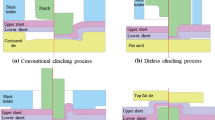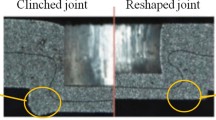Abstract
For the past few years, the lightweight structure has been studying detailly due to the increasingly stringent requirements of environmental protection, energy conservation, and emission reduction. The main measure to realize automobile lightweight is to adopt parts manufactured by lightweight materials. To connect these lightweight materials, a new technology named flat-rivet clinching process (FRCP) has been developed. In this study, the impact of friction coefficient and specimen material on material flow was investigated utilizing the finite element method (FEM). The FE model was established utilizing DEFORM-2D software. AA5052 was selected as the main specimen material in this study. The equivalent stress and strain distribution, material flow velocity, and material flow direction were analyzed utilizing FEM. The consequences showed that except friction coefficient of the contact region between the upper plate and blank holder, the friction coefficient of other contact surfaces played a crucial role during the material flow. It could affect the formation of mechanical interlocking. Meanwhile, the higher the sheet strength and material flow resistance, the greater the riveting force required by the flat-rivet clinching process (FRCP).





















Similar content being viewed by others
Data availability
The raw/processed data required to reproduce these findings cannot be shared at this time due to technical or time limitations
References
Chen C, Zhang HY, Xu YQ, Wu JL (2020) Investigation of the flat-clinching process for joining three-layer sheets on thin-walled structures. Thin-Walled Struct 157:107034. https://doi.org/10.1016/j.tws.2020.107034
Gude M, Hufenbach W, Kupfer R, Freund A, Vogel C (2015) Development of novel form-locked joints for textile reinforced thermoplastices and metallic components. J Mater Process Technol 216:140–145. https://doi.org/10.1016/j.jmatprotec.2014.09.007
Chen C, Li YX, Zhang HY, Li YB, Pan Q, Han XL (2020) Investigation of a renovating process for failure clinched joint to join thin-walled structures. Thin-Walled Struct 151:106686. https://doi.org/10.1016/j.tws.2020.106686
Chen C, Ran XK, Pan Q, Zhang HY, Yi RX, Han XL (2020) Research on the mechanical properties of repaired clinched joints with different forces. Thin-Walled Struct 152:106752. https://doi.org/10.1016/j.tws.2020.106752
Mucha J, Kaščák Ľ, Spišák E (2014) The experimental analysis of cold pressed joint technology for selected sheet metals used in an automotive industry. Adv Mater Res 1077:33–38. https://doi.org/10.4028/www.scientific.net/AMR.1077.33
Borsellino C, Di Bella G, Ruisi VF (2007) Study of new joining technique: flat clinching. Key Eng Mater 344:685–692. https://doi.org/10.4028/www.scientific.net/KEM.344.685
Drossel WG, Falk T, Israel M, Jesche F (2014) Unerring planning of clinching processes through the use of mathematical methods. Key Eng Mater 611-612:1437–1444. https://doi.org/10.4028/www.scientific.net/KEM.611-612.1437
Wang M-H, Xiao G-Q, Li Z, Wang J-Q (2017) Shape optimization methodology of clinching tools based on Bezier curve. Int J Adv Manuf Technol 94(5-8):2267–2280. https://doi.org/10.1007/s00170-017-0987-5
Lee CJ, Kim JY, Lee SK, Ko DC, Kim BM (2010) Parametric study on mechanical clinching process for joining aluminum alloy and high-strength steel sheets. J Mech Sci Technol 24(1):123–126. https://doi.org/10.1007/s12206-009-1118-5
Chen C, Zhang HY, Peng H, Ran XK, Pan Q (2020) Investigation of the Restored joint for aluminum alloy. Metals 10(1):1–13. https://doi.org/10.3390/met10010097
Abe Y, Saito T, Mori K-I, Kato T (2017) Mechanical clinching with dies for control of metal flow of ultra-high-strength steel and high-strength steel sheets. Proc Inst Mech Eng B J Eng Manuf 232(4):644–649. https://doi.org/10.1177/0954405416683429
Kaščák L, Mucha J, Spišák E, Kubík R (2017) Wear study of mechanical clinching dies during joining of advanced high-strength steel sheets. Strength Mater 49(5):726–737. https://doi.org/10.1007/s11223-017-9918-9
Neugebauer R, Kraus C, Dietrich S (2008) Advances in mechanical joining of magnesium. CIRP Ann Manuf Technol 57(1):283–286. https://doi.org/10.1016/j.cirp.2008.03.025
Neugebauer R, Mauermann R, Dietrich S, Kraus C (2007) A new technology for the joining by forming of magnesium alloys. Prod Eng 1(1):65–70. https://doi.org/10.1007/s11740-007-0045-5
Abe Y, Kishimoto M, Kato T, Mori K (2009) Joining of Hot-Dip Coated Steel Sheets by Mechanical Clinching. Int J Mater Form 2(S1):291–294. https://doi.org/10.1007/s12289-009-0446-4
Abe Y, Mori K, Kato T (2012) Joining of high strength steel and aluminium alloy sheets by mechanical clinching with dies for control of metal flow. J Mater Process Technol 212(4):884–889. https://doi.org/10.1016/j.jmatprotec.2011.11.015
Mucha J, Kascak L, Spisak E (2011) Joining the car-body sheets using clinching process with various thickness and mechanical property arrangements. Arch Civ Mech Eng 11(1):135–148. https://doi.org/10.1016/S1644-9665(12)60179-4
Lambiase F (2012) Influence of process parameters in mechanical clinching with extensible dies. Int J Adv Manuf Technol 66(9-12):2123–2131. https://doi.org/10.1007/s00170-012-4486-4
Abe Y, Kato T, Mori K, Nishino S (2014) Mechanical clinching of ultra-high strength steel sheets and strength of joints. J Mater Process Technol 214(10):2112–2118. https://doi.org/10.1016/j.jmatprotec.2014.03.003
Shi C, Yi R, Chen C, Peng H, Ran X, Zhao S (2020) Forming mechanism of the repairing process on clinched joint. J Manuf Process 50:329–335. https://doi.org/10.1016/j.jmapro.2019.12.025
He XC, Zhang Y, Xing BY, Gu FS, Ball A (2015) Mechanical properties of extensible die clinched joints in titanium sheet materials. Mater Des 71:26–35. https://doi.org/10.1016/j.matdes.2015.01.005
Chu MM, He XC, Zhang J, Lei L (2018) Clinching of similar and dissimilar sheet materials of galvanized steel, aluminium alloy and titanium alloy. Mater Trans 59(4):694–697. https://doi.org/10.2320/matertrans.M2017319
Chen C, Li Y, Zhai Z, Zhao S, Zhang P, Huang M, Li Y (2019) Comparative investigation of three different reforming processes for clinched joint to increase joining strength. J Manuf Process 45:83–91. https://doi.org/10.1016/j.jmapro.2019.06.009
Abe Y, Nihsino S, Mori KI, Saito T (2014) Improvement of Joinability in Mechanical Clinching of Ultra-high Strength Steel Sheets Using Counter Pressure with Ring Rubber. Procedia Engineering 81:2056–2061. https://doi.org/10.1016/j.proeng.2014.10.285
Lambiase F (2015) Joinability of different thermoplastic polymers with aluminium AA6082 sheets by mechanical clinching. Int J Adv Manuf Technol 80(9-12):1995–2006. https://doi.org/10.1007/s00170-015-7192-1
Lambiase F (2015) Mechanical behaviour of polymer-metal hybrid joints produced by clinching using different tools. Mater Des 87:606–618. https://doi.org/10.1016/j.matdes.2015.08.037
Dean A, Rolfes R, Grbic N, Hübner S, Behrens B (2019) A FEM-based virtual test-rig for hybrid metal-composites clinching joints. Mater Werkst 50(8):973–986. https://doi.org/10.1002/mawe.201800198
Zhang Y, He XC, Wang YF, Lu Y, Gu FS, Ball A (2018) Study on failure mechanism of mechanical clinching in aluminium sheet materials. Int J Adv Manuf Technol 96(9-12):3057–3068. https://doi.org/10.1007/s00170-018-1734-2
Peng H, Chen C, Zhang HY, Ran XK (2020) Recent development of improved clinching process. Int J Adv Manuf Technol 110(11-12):3169–3199. https://doi.org/10.1007/s00170-020-05978-4
Lin J, Guo T, Su A, Niu Z (2016) Effects of process parameters on sheets warp of clinching based on Abaqus. In: Proceedings - 2015 International Conference on Computer Science and Mechanical Automation, CSMA 2015. pp 308–312. https://doi.org/10.1109/CSMA.2015.68
Kiselev AS, Slobodyan MS (2019) Effects of electrode degradation on properties of small-scale resistance spot welded joints of E110 alloy. Mater Sci Forum 970:227–235. https://doi.org/10.4028/www.scientific.net/MSF.970.227
Zhao SD, Xu F, Guo JH, Han XL (2014) Experimental and numerical research for the failure behavior of the clinched joint using modified Rousselier model. J Mater Process Technol 214(10):2134–2145. https://doi.org/10.1016/j.jmatprotec.2014.03.013
He X (2017) Clinching for sheet materials. Sci Technol Adv Mater 18(1):381–405. https://doi.org/10.1080/14686996.2017.1320930
Gerstmann T (2016) Erweiterung der Verfahrensgrenzen des Flach-Clinchens. Technischen Universität Chemnitz
Gerstmann T, Awiszus B (2014) Recent developments in flat-clinching. Comput Mater Sci 81:39–44. https://doi.org/10.1016/j.commatsci.2013.07.013
Han X, Zhao S, Chen C, Liu C, Xu F (2016) Optimization of geometrical design of clinching tools in flat-clinching. Proc Inst Mech Eng C J Mech Eng Sci 231(21):4012–4021. https://doi.org/10.1177/0954406216660335
Neugebauer R, Todtermuschke M, Mauermann R, Riedel F (2008) Overview on the state of development and the application potential of dieless mechanical joining processes. Arch Civ Mech Eng 8(4):51–60. https://doi.org/10.1016/S1644-9665(12)60121-6
Mucha J (2011) The analysis of lock forming mechanism in the clinching joint. Mater Des 32(10):4943–4954. https://doi.org/10.1016/j.matdes.2011.05.045
He X, Liu F, Xing B, Yang H, Wang Y, Gu F, Ball A (2014) Numerical and experimental investigations of extensible die clinching. Int J Adv Manuf Technol 74(9–12):1229–1236. https://doi.org/10.1007/s00170-014-6078-y
Xu F, Zhao SD, Han XL (2014) Use of a modified Gurson model for the failure behaviour of the clinched joint on Al6061 sheet. Fatigue Fract Eng Mater Struct 37(3):335–348. https://doi.org/10.1111/ffe.12118
Hamel V, Roelandt JM, Gacel JN, Schmit F (2000) Finite element modeling of clinch forming with automatic remeshing. Comput Struct 77(2):185–200. https://doi.org/10.1016/S0045-7949(99)00207-2
Funding
This research work is supported by the National Natural Science Foundation of China (Grant No. 51805416), Young Elite Scientists Sponsorship Program by CAST, Natural Science Foundation of Hunan Province (Grant No. 2020JJ5716), Natural Science Basic Research Plan in Shanxi Province of China (Grant No. 2019JQ-372), the Project of State Key Laboratory of High Performance Complex Manufacturing, Central South University (Grant No. ZZYJKT2019-01), Hunan Provincial Natural Science Foundation for Excellent Young Scholars, and Huxiang High-Level Talent Gathering Project of HUNAN Province (Grant No. 2019RS1002).
Author information
Authors and Affiliations
Contributions
Chao Chen conceived and designed the experiments; Chao Chen performed the experiments; Yawen Ouyang and Denglin Qin analyzed the data; Chao Chen and Denglin Qin contributed reagents/materials/analysis tools; Chao Chen and Yawen Ouyang wrote the paper.
Corresponding author
Ethics declarations
Competing Interests
The authors declare no competing interests.
Consent to participate
All authors agreed with the consent to participate.
Consent for publication
All authors have read and agreed to the published version of the manuscript.
Additional information
Publisher’s note
Springer Nature remains neutral with regard to jurisdictional claims in published maps and institutional affiliations.
Rights and permissions
About this article
Cite this article
Chen, C., Ouyang, Y. & Qin, D. Finite element analysis of material flow in flat-rivet clinching process. Int J Adv Manuf Technol 116, 1961–1974 (2021). https://doi.org/10.1007/s00170-021-07532-2
Received:
Accepted:
Published:
Issue Date:
DOI: https://doi.org/10.1007/s00170-021-07532-2




